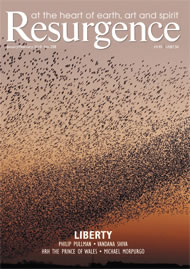The sun is setting on Sacred Mountain, close to the border with Mongolia, in southernmost Tuva, one of the least-known regions in Siberia. In a rocky alcove inside the mountain, a group of female shamans conduct a traditional ceremony. One woman, clothed in long furs and a headdress made from the feathers of predatory birds, offers food to fire spirits. Behind her, another shaman ties prayer flags to a tree – white to symbolise air; green and yellow for earth and water.
Ringed by 2,000-metre-plus mountains and far from the major trade routes, Tuva’s ancient civilisation has remained largely intact. ...
There are approximately 683 more words in this article.
To read the rest of this article, please buy this issue, or join the Resurgence Trust. As a member you will receive access to the complete archive of magazines from May 1966.
If you are already a member, please Sign in







